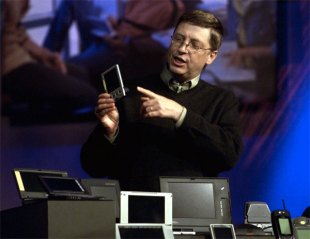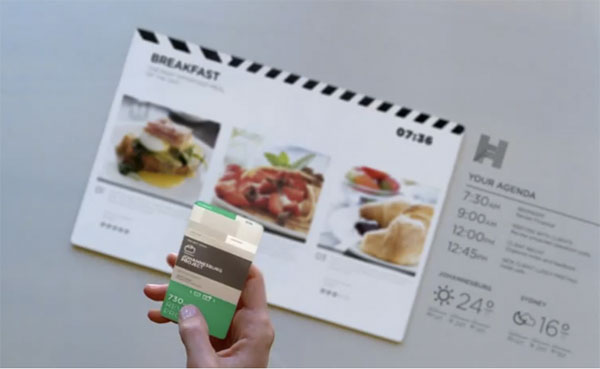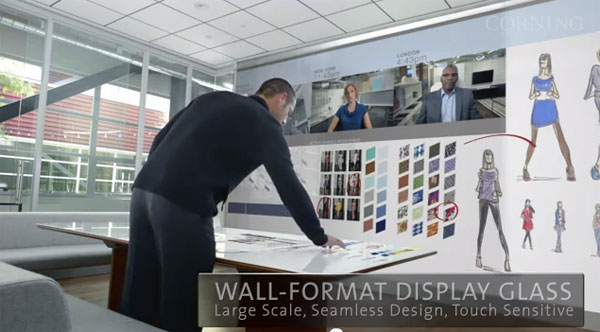“You Will” Commercials (AT&T, 1993-1994)
[youtube=http://www.youtube.com/watch?v=5MnQ8EkwXJ0?w=480]
Year depicted: unspecified
Futuristic items shown: digital library with touch-screen reading stations and remote access to e-books; in-dashboard car navigation system; tablet with wireless faxing; in-car toll-paying computer; fancy ATMs that sell concert tickets and renew driver’s licenses; videoconferencing pay phones; voice-activated doors; medical records stored on credit card-sized device; laptops with videoconferencing; on-demand video; online universities; instant supermarket checkouts; wristwatch phones; automated translation; remote home automation; Clippy-like canine assistant.
Amusing anachronisms: Out of all of the above, the amazing technology of tomorrow that everyone latched onto was…the ability to send wireless faxes from the beach. (In the mid-1990s, apparently, faxing was still cool.)
Backstory: Of all the movies here, AT&T’s creations probably had by far the widest audience, because they were actually popular commercials shown on prime-time TV, back in a day when accessing AOL over dial-up was still a novelty.
Directed by a not-yet-famous David Fincher and narrated by Tom Selleck, each spot showed situations involving the gadgets and services of tomorrow, and promised that AT&T would bring them to consumers. Most of them have arrived, and AT&T is indeed involved in many cases as a service provider, though it didn’t invent any of this stuff. (And if you want to get technical about it, today’s AT&T is really the descendant of Southwestern Bell.) In 1993 and 1994, these ads were provocative what-if scenarios showing where technology might take us; today, they’re nostalgic reminders of how far we’ve come.
Information at Your Fingertips (Microsoft, 1994)
Year depicted: 2004, just like Sun’s Starfire
Futuristic items shown: street-corner coffee-dispensing stand with touch-screen display; pocket-sized “wallet PCs”; in-car wireless tablet with maps and videoconferencing; flat-screen kitchen PC with video and networked hypermedia; touchscreen home automation system; interactive TV with on-demand feature and videoconferencing; art store with high-res flat screens displaying DRM-restricted paintings for on-demand printing and Internet downloading; pay phones with webcams; PayPal-like money exchange; school tablet computers with wireless Internet, wireless video transmission and fancy PowerPoint-like presentation software; hospital computer that connects to in-ambulance medical equipment; note-taking tablet with audio-recording and voice-recognition features; desktop computers running unspecified version of Windows with a less app-centric interface.
Amusing anachronisms: a few non-tech-related details tell us that this is the future, such as mention of a female president-elect and a car called the Ford Trapeze. Mostly, however, 2004 looks like 1994. (David Letterman even has the same amount of hair.)

Getty Images
Backstory: In the 1990s, the iconic tech-industry keynotes didn’t involve Steve Jobs or Apple. They were Bill Gates’ yearly addresses at COMDEX in Las Vegas, in which he shared the company’s vision of computing’s future.
In 1990, Gates’ COMDEX keynote was titled “Information at Your Fingertips,” and included demos of concept apps designed to show where PCs would go in the 1990s. For 1994, he upped the ante by coming back to the same premise, but illustrating it with a lavish, lengthy movie about life in Seattle in the year 2004. (YouTube’s copy has a soundtrack which is badly out of sync, which probably enhances the entertainment value.)
Microsoft’s film had a full-blown plot involving a murdered Peruvian sailor, plainclothes cops, art forgeries and a teenaged protagonist, plus a bevy of gee-whizzy gadgets, apps and services; Gates interrupted it every so often to explain the technological breakthroughs it depicted, and broke the fourth wall by chatting with the characters. The specifics are often off — Microsoft thought that pay phones would morph into video-enabled Internet terminals in a way that never quite happened — but in broad strokes, the movie does touch on most of the trends that would matter over the decade to come.
Bonus footage: Here’s Gates’s 1990 COMDEX keynote, which he referenced in his 1994 presentation.
[gigya src=”http://en.sevenload.com/pl/daV10tF/448×336/swf/noplay/facebook” width=”480″ quality=”high” wmode=”transparent” allowFullScreen=”true” ]
Productivity Future Vision (Microsoft, 2009)
[youtube=http://www.youtube.com/watch?v=t5X2PxtvMsU?w=480]
Years depicted: 2014-2019 or thereabouts
Futuristic items shown: giant virtual touch-screen mirrors that link schools in different parts of the world; fancy airplane touchscreen computers (presumably in first class only); whisper-thin credit card-size touch-screen phones that can be used in pairs and which sport built-in projectors; Minority Report-style interface for office productivity; augmented reality glasses; stylus-driven interface built into an office tabletop; virtual whiteboard; smart coffee cup; newspaper made of flexible e-paper; smart home HVAC system; mysterious magic wand-like remote control device; and related technologies.
Amusing anachronisms: too soon to judge

Microsoft
Backstory: In the last few years, there’s been a new boon in corporate-sponsored tech-utopia films. Stylistically, they’ve settled on a remarkably similar approach. The production values are impressive, and there’s no hokey narration or dialog. Just good-looking, prosperous young people using elegant-looking gadgets that feel like they might be just a few years out, accompanied by a tasteful musical score. It feels a bit as though the entire planet is going to become one humongous Apple Store — even though Apple isn’t one of the companies making these movies.
Microsoft’s Productivity Future Vision is a good example of the genre. (So its sequel, released in 2011.) The company has come a long way from Bill Gates’ 1994 COMDEX video, at least when it comes to visualizing imaginary products. And just as the 1994 film depicted a world in which everything was an extension of Windows 3.1, Productivity Future Vision is about one in which a descendent of Windows 8’s Metro interface is all around us.
It’s futuristic, all right. Strangely soothing, too. But now as in 1994, it’s unclear whether making these movies plays any useful role in turning the products they show into commercial products. Remind me to rate this one for accuracy once 2019 rolls around, would you?
Nokia Mixed Reality (Nokia, 2009)
[youtube=http://www.youtube.com/watch?v=A4pDf7m2UPE]
Year depicted: not specified
Futuristic items shown: bedroom window that doubles as a digital display; augmented-reality eyeglasses with features such as weather and chat; 3D audio headset; “haptic wrist device.”
Amusing anachronisms: The lady who stars in this appears to be using Nokia’s N97, a Symbian smartphone with QWERTY keyboard which was a tad retro even in 2009.
Backstory: Nokia made this video, based on work done by the Nokia Research Center, for its Nokia World conference in Stuttgart, Germany. In the years since its production, the company has decided to bet everything on Microsoft’s Windows Phone operating system, rendering this hypothetical “future vision” at least partially obsolete. But that’s okay. A real Nokia product, its 41-megapixel camera phone, is at least as cool than anything shown in the movie.
A Day Made of Glass 2 (Corning, 2012)
[youtube=http://www.youtube.com/watch?v=jZkHpNnXLB0?w=480]
Year(s) depicted: “the near future”
Futuristic items depicted: tablet computing device with projected 3D interface; bedroom mirror that doubles as a digital display, with wardrobe-selecting app; tablet that can beam music to car computer; color-shifting dashboard; car windows with touch-screen control; elementary school with photovoltaic-glass roof and giant displays in hallways; translucent educational tablets with augmented-reality features; classrooms with touch-enabled display walls; Microsoft Surface-like computing tables for educational use; anti-bacterial medical tablets; smart glass walls in hospital room, with videoconferencing features; full-body scanning system with augmented-reality 3D interface; giant all-weather, augmented reality smart glass walls in state park; massive flat-screen TV.
Amusing anachronisms: too soon to judge

Corning
Backstory: In 2011, Corning released A Day Made of Glass, a video about a world in which nearly every flat surface is a touch screen made out of Corning glass. It was a YouTube blockbuster, racking up more than eighteen million views to date. So the company produced this sequel — and a special edition with more explanation of what’s going on — set on the same day as the first film and mostly involving a schoolgirl’s glass-centric life. The most memorable moment, however, shows a doctor lifting a virtual-reality brain out of a real patient’s skull — kids, don’t try this at home.
A Day Made of Glass 2 appears to be set in the same tasteful universe as Microsoft’s Productivity Future Vision and Nokia Mixed Reality: You could splice them together into one movie and it would make sense, more or less. They all depict one version of the future, and like earlier ones, it’s heavily influenced by where technology happens to be right now. Would these recent videos exist in the same form if Apple had never come up with the iPhone and iPad? We’ll never know.
For everything that’s changed since GM’s 1940 To New Horizons, much has remained the same about these kinds of productions. (The specific scenarios are often eerily familiar — Glass 2, like Apple’s Project 2000, features animated 3D dinosaurs.) Even the movies which were pretty mundane in the first place are fun to revisit: What they tell us about our past, it turns out, is at least as important as anything they can tell us about our future.
More tech nostalgia on TIME.com:


